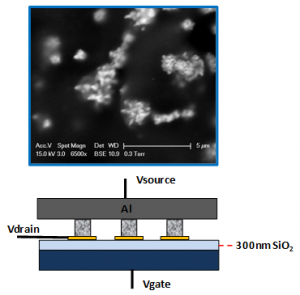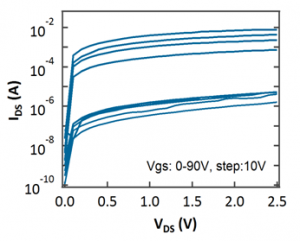A Low-loss Squeezable Micro-Electro-Mechanical Switch
- Category: Electronic Devices
- Tags: Jeffrey Lang, Sarah Paydavosi, Vladimir Bulovic
It has been known for several decades that polymers doped with conducting particles, for example silicone nickel nano-particles, will exhibit a dramatically decreasing resistivity as the polymer is compressed. It is possible that the conductivity will vary by 12 orders of magnitude over a 40% strain [1] . Such composites conduct via tunneling from particle to particle, and the tunneling currents grow exponentially as the particles become closer together. These composites have already been used in applications from tactile sensors to fuses.
In this study we use the composites as the active element in an electronically-controlled switch. The Squeezable electronically controlled switch, referred to here as a “squitch,” is shown in Figure 1. In this embodiment, the squitch is a three-terminal device, with its terminals labeled as per the comparable terminals in a MOSFET. The central component of the device is the doped polymer labeled “Squitch Material” connected to drain and source electrodes. As fabricated, the squitch material would be a poor conductor, permitting little if any electron current to flow from the source to drain. That is, the resistance of this conduction path would be very large, putting the squitch in an off state. By applying voltage to the gate electrode, either positive or negative, an electric field is developed between the gate and the source. This electric field causes the gate to be attracted to the source, thereby compressing the squitch material. As the squitch material is compressed in the vertical direction, it begins to conduct, putting the squitch in an on state.
Thus, the squitch is a voltage controlled conductor, much the same as a FET or a BJT but with very large on-to-off conduction ratio and subthreshold swing (S) < 60 mV/dec, which allows for more aggressive supply voltage scaling and improvement in the energy efficiency.
- Figure 1: SEM image of nickel-silicone composite and cross section schematic of a three-terminal squitch. More than 7 orders of magnitude change in the conductivity of the composite was observed over a 20% strain.
- Figure 2: The initial demonstration of the squitch, showing 4 orders of magnitude change in the current by applying voltage to the gate terminal.
- D. Bloor, K. Donnelly, P. J. Hands, P. Laughlin, and D. Lussey, “A metal–polymer composite with unusual properties,” J. of Phys. D: Appl. Phys., 38 (2005) 2851–2860. [↩]

